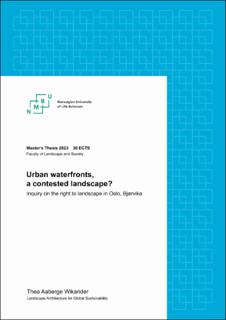| dc.description.abstract | Following the industrial decline in the 70´s, urban waterfronts have undergone significant functional changes. A global redevelopment trend coincided with a neoliberal policy shift in the 80´s when development and regulation of public areas turned largely market-based, and waterfront transformation became fueled by privatization. At the same time population increase pressured accessibility to public space in the city. This thesis argues that not addressing public needs in private development creates a divide between the built and lived landscape.
For a long time in Oslo, Norway, the waterfront, with its continuous stretch of traffic and shipping, acted as a divider between the city and the water. When the first suggestion to open the waterfront again came forward, initiators emphasized making the sites widely accessible to the public. After years of planning, in 2008, the Fjord City plan was launched with specific targets to repurpose a 9km shoreline to strengthen Oslo’s identity as a waterfront capital, taking on critical goals of accessibility. However, prevailing privatization in plan and execution has left certain parts catered to affluent groups and reduced the attention to publicness. This market-driven urban development threatens the use and enjoyment of public space.
Through the case of Bjørvika (Oslo), this thesis builds on critical landscape and urban planning theories to add to the discussion on equity, rights, and justice in the accessibility to the urban waterfront. Using methods such as document scrutiny and observational and spatial analysis it highlights discrepancies between planning visions and users' experience of the waterfront scape. The findings demonstrate that despite a large focus on participation and accessibility in the regulatory documents, Bjørvika presents issues on the just and right socio-spatial accessibility. Regarding opening the waterfront to the city, it seems that the former division of road networks has been replaced by extravagant housing, offices, and cultural institutions- leaving the waterfront to be a contrasting/ offbeat/ inconsistent landscape against urban Oslo. | |
